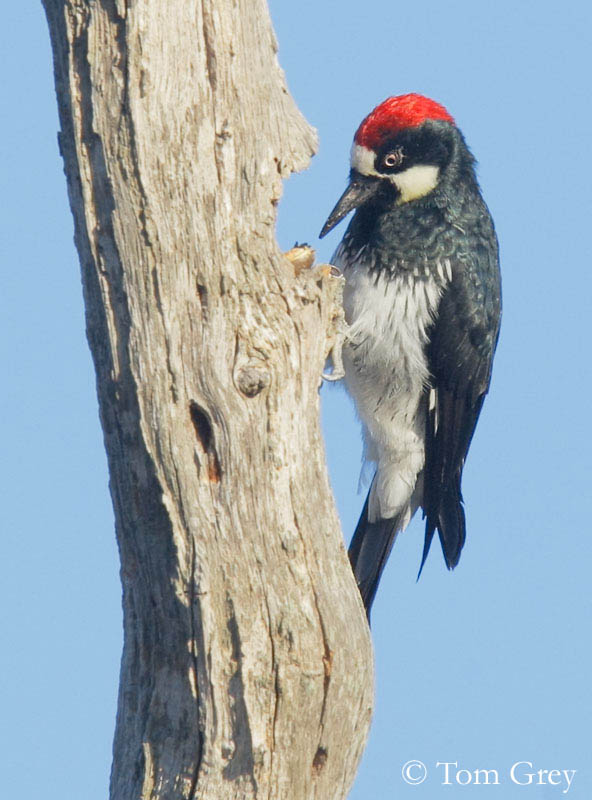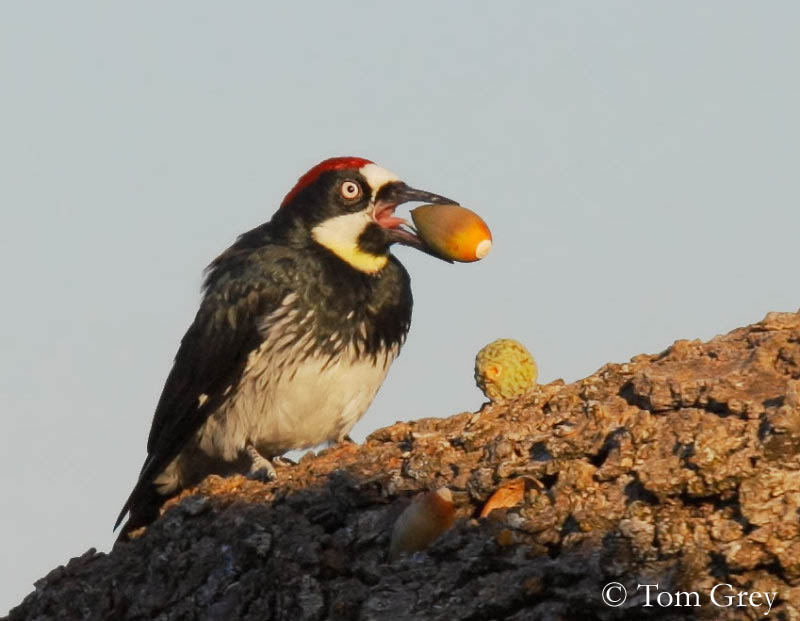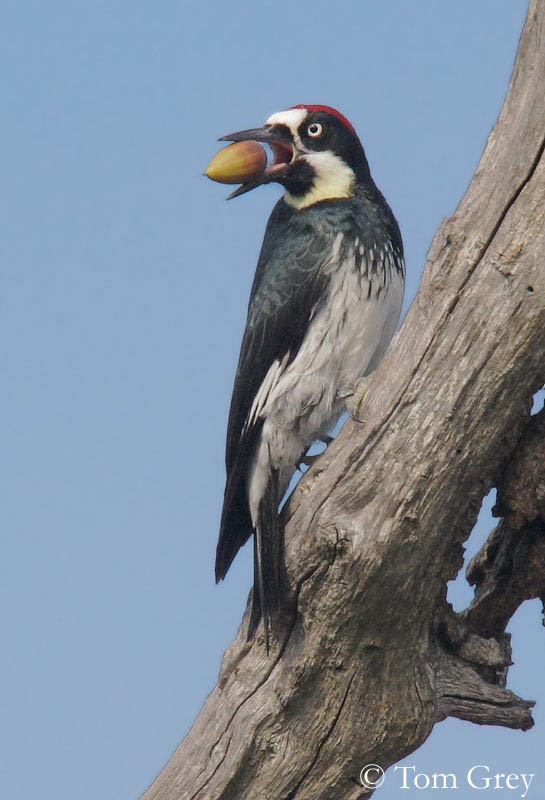
Acorn Woodpecker
Melanerpes formicivorus
Piciforme Order – Picidae Family
BIOMETRICS:
Length: 19-23 cm; Wingspan : 35-43 cm; Weight: 65-90 g
LONGEVITY: up to 16 years
DESCRIPTION:
Acorn Woodpecker has white forehead and cheeks. Chin is black, throat is yellowish. It has solid red crown. Base of the bill is black. The underparts are white, streaked black from chest to flanks. Upper breast is black. Belly and vent are white. The upperparts are black, with white rump. When in flight, we can see white patches on outer wings. Tail is black.
Bill is black. Eyes are white. Legs and feet are greyish.
Female has smaller bill than male, and less red on crown. She has a black band between white forehead and red cap.
Juvenile is similar to adult male, but with dark eyes.

VOICE:
Acorn Woodpecker’s most frequent call is a loud “waka” repeated several times. Also the “thump-thump” of the bird chiselling its hole is a familiar sound throughout its range.
HABITAT:
Acorn Woodpecker is common in oak woods, or pine forests with numerous oak trees. We also find it in urban parks and suburban areas.
RANGE:
Acorn Woodpecker is resident within its range all year round. It lives from NW Oregon, California, SW of United States, and Western Mexico to Central America. Some isolated populations live in Colombia.
BEHAVIOUR:
Acorn Woodpecker feeds on insects, and captures them by flycatching above the canopy. It eats mainly flying insects, and we can see it swooping and snatching insects in mid-air. It also gleans on branches. It feeds mainly on acorns and nuts, and in autumn, it drills small holes in a tree trunk, and put a nut or an acorn in each hole for food supply in winter. It rarely goes to the ground.

Acorn Woodpecker is gregarious, living in small colonies, using the same “granary tree” year after year. They may use human structures to store food. We can find up to 50 000 holes in the same granary tree. Holes are hollowed out in dead limbs and in thick bark. They defend very strongly these granaries, attacking squirrels and others woodpeckers attempting to raid their caches.
Acorn Woodpecker lives in family groups on the same territory. Young remain with parents during several years, helping adults to raise the other young. They may breed within one family.
When there are several females in the same group, eggs are into a single nest cavity. Each female destroys some eggs before laying its own eggs.
Courtship displays include bowing and wing spreading, and some flight displays.
FLIGHT:
Acorn Woodpecker has an agile flight, using flycatching to capture flying insects. It performs an undulating flight, with rapid wing beats and pauses.
REPRODUCTION:
Acorn Woodpecker nests in natural cavities, in dead or living branches in trees, or snags. Nest may be used for several seasons. The inside of the cavity is lined with fresh wood chips. It may be located at about 6 to 7,50 metres above the ground.
Clutch for several females may contain 5 to 6 white eggs. They are laid at about 24 hours intervals. Incubation lasts about 11 days, shared by both male and female breeders. All members of the family group care for the altricial chicks, providing food. Young fledge at about 30 to 32 days of age. They are independent at about two months.
This species produces one brood per season, rarely two.

DIET:
Acorn Woodpecker feeds mostly on insects, but it also consumes acorns (from the oak tree: Quercus agrifolia), fruits, sap, corn and flower nectar.
Occasionally it may eat grass seeds, lizards and bird eggs.
PROTECTION / THREATS / STATUS:
Acorn Woodpeckers are threatened by habitat loss, by destruction of oak and pine forests for human developments.
Fr: Pic glandivore
All : Eichelspecht
Esp : Carpintero Bellotero
Ital : Picchio delle ghiande
Nd : Eikelspecht
Sd : Samlarspett
Photographs by Tom Grey
His website:
Tom Grey's Bird Pictures
Text by Nicole Bouglouan
Sources:
HANDBOOK OF THE BIRDS OF THE WORLD Vol. 7 by Josep del Hoyo-Andrew Elliott-Jordi Sargatal – Lynx Edicions – ISBN: 8487334377
FIELD GUIDE TO THE BIRDS OF NORTH AMERICA - National Geographic Society - ISBN: 0792274512
All About Birds (Cornell Lab of Ornithology)
Animal Diversity Web (University of Michigan Museum of Zoology)
What Bird-The ultimate Bird Guide (Mitchell Waite)
Wikipedia (Wikipedia, The Free Encyclopedia)
Bird Web (Seattle Audubon Society)